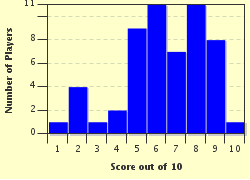Quiz Answer Key and Fun Facts
1. Which phylum includes sponges? (There probably are few wealthy sponges.)
2. Which range best states the number of species of sponges?
3. When Carolus Linnaeus (Carl von Linne) classified sponges, where did he place them?
4. Which common animal systems are lacking in a sponge? (It is a pretty primitive animal)
5. What is the most common type of reproduction in sponges? (I wonder if sponges go on dates?)
6. Sponges live in the water. In which type of water environment will you find the greatest number of sponges?
7. In which climate area will you find sponges?
8. Most adult sponges are sessile. What does "sessile" mean? (Cease and desist, sponge!)
9. Which characteristic do sponges share with other species of animals?
10. The sponge includes a type of cell called a collar cell. Which answer most completely describes the correct purpose or purposes of a collar cell.
Source: Author
bernie73
This quiz was reviewed by FunTrivia editor
Tizzabelle before going online.
Any errors found in FunTrivia content are routinely corrected through our feedback system.

